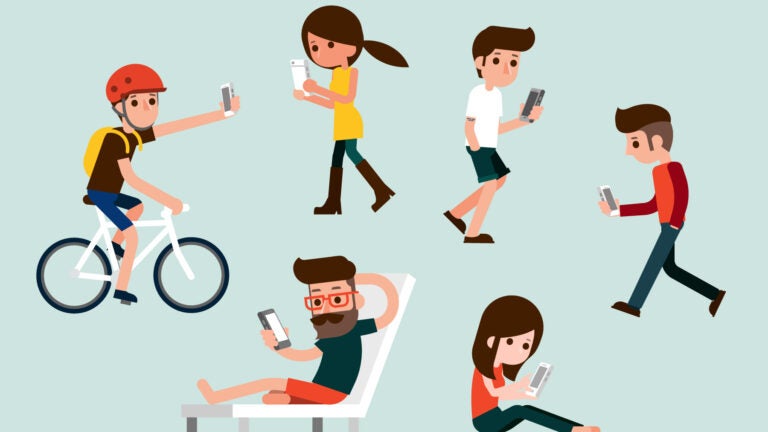
It can be difficult to set a limit to proper use of smartphones by kids and teens. (Illustration/iStock)
Happy 10th birthday, iPhone: You’ve changed the world in addictive ways
The state of our addiction a decade after Apple released its first smartphone, as seen by USC researchers
Apple released its first iPhone on June 29, 2007 — forever changing how people interact with each other and the world. A decade later, smartphones are seemingly welded into hands, leaving people feeling vulnerable when they forget the device at home.
Sometimes that worry (or even panic) among those stranded without their phone revolves around more than a fear of being disconnected. Smartphones today have become a seductive habit that’s hard to resist.
“Internet addiction has some behavioral similarities to hard drug use. There is a relationship between how addicted someone is to social media and how strong or how different the brain signals are in specific regions,” said Antoine Bechara, psychology professor and neuroscientist at the USC Dornsife College of Letters, Arts and Sciences. “The similarities between internet addiction and cocaine addiction really lie in those brain systems that drive you toward the reward.”
That includes release of the reward-and-pleasure neurotransmitter dopamine. In case you’re worried about similarities between smartphone and cocaine addiction, though, Bechara notes a fundamental difference between the two. “Cocaine use usually involves impairments in the prefrontal cortex, which leads to poor decision-making across many facets of life,” he said. “But internet addiction usually does not involve prefrontal cortex impairments.”
Pleasure centers
“Swiping on apps is inherently rewarding due to a dopamine hit in the brain every time a new message is received. The affected area is the same ‘pleasure center’ activated by cocaine and other addictive drugs,” says Julie Albright, a psychology lecturer at the USC Dornsife College of Letters, Arts and Sciences.
“The addictive qualities of swiping on dating apps like Tinder has important implications for relationships: These dating apps serve as an omnipresent ‘other’ that potentially undermines relationships by providing a seemingly limitless array of attractive others for romantic or sexual dalliances. As such, it can serve to undermine one’s willingness to commit to or sustain a monogamous relationship due to the ever-present element of choice.”
That’s not to say that smartphones are always harmful to health. Preventive medicine researcher Donna Sprujit-Metz, drector of the USC mHealth (Mobile Health) Collaboratory at USC’s Center for Economic and Social Research, acknowledges that smartphones provide easy, 24-hour access to games and social media, which has had some negative effects for children, including the rise of cyberbullying.
Among students, teens can also use smartphones to access information they need for homework, and that’s just one constructive application. “Mobile phones can be harnessed for good in real time and in appropriate situations. Our research uses smartphone-derived data to develop interventions — tips, push alerts and information — that can help children and families.”
Potential for study
According to addiction expert Steve Sussman, professor of preventive medicine, psychology and social work, smartphone addiction is high among youth and young adults. It may be increasing among older adults as well. He’s studying the phenomenon, which has palpable effects.
“Consequences associated with smartphone addiction include lack of concentration and decreased performance at school or work, car and other accidents, possible blurred vision, sleep disturbance, and financial costs,” Sussman said. “Research is only beginning in this arena. Our ongoing review study could help develop evidence-based guidelines on treating smartphone addiction.”
Interested in learning more? Watch this video from Antoine Bechara on the differences and commonalities between drug and internet addiction.
